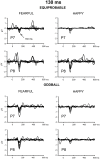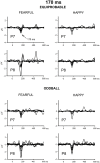Event-related potentials to unattended changes in facial expressions: detection of regularity violations or encoding of emotions?
- PMID: 24062661
- PMCID: PMC3769632
- DOI: 10.3389/fnhum.2013.00557
Event-related potentials to unattended changes in facial expressions: detection of regularity violations or encoding of emotions?
Abstract
Visual mismatch negativity (vMMN), a component in event-related potentials (ERPs), can be elicited when rarely presented "deviant" facial expressions violate regularity formed by repeated "standard" faces. vMMN is observed as differential ERPs elicited between the deviant and standard faces. It is not clear, however, whether differential ERPs to rare emotional faces interspersed with repeated neutral ones reflect true vMMN (i.e., detection of regularity violation) or merely encoding of the emotional content in the faces. Furthermore, a face-sensitive N170 response, which reflects structural encoding of facial features, can be modulated by emotional expressions. Owing to its similar latency and scalp topography with vMMN, these two components are difficult to separate. We recorded ERPs to neutral, fearful, and happy faces in two different stimulus presentation conditions in adult humans. For the oddball condition group, frequently presented neutral expressions (p = 0.8) were rarely replaced by happy or fearful expressions (p = 0.1), whereas for the equiprobable condition group, fearful, happy, and neutral expressions were presented with equal probability (p = 0.33). Independent component analysis (ICA) revealed two prominent components in both stimulus conditions in the relevant latency range and scalp location. A component peaking at 130 ms post stimulus showed a difference in scalp topography between the oddball (bilateral) and the equiprobable (right-dominant) conditions. The other component, peaking at 170 ms post stimulus, showed no difference between the conditions. The bilateral component at the 130-ms latency in the oddball condition conforms to vMMN. Moreover, it was distinct from N170 which was modulated by the emotional expression only. The present results suggest that future studies on vMMN to facial expressions should take into account possible confounding effects caused by the differential processing of the emotional expressions as such.
Keywords: equiprobable condition; facial expressions; independent component analysis; oddball condition; visual mismatch negativity.
Figures










References
LinkOut - more resources
Full Text Sources
Other Literature Sources
Miscellaneous

